Change Page: 12 > | Showing page 1 of 2, messages 1 to 20 of 28 - powered by ASPPlayground.NET Forum Trial Version
Reports tied to this Journal
Author
|
Message

|
 Breeding Journal, Species: Clibanarius tricolor
Monday, September 2, 2013 8:24 AM
Breeding Journal, Species: Clibanarius tricolor
Monday, September 2, 2013 8:24 AM
( permalink)
Breeding Journal DataSheet
This first post should be updated regularly to include new information as events take place or changes are made to your system General Species: Clibanarius tricolor Social Structure: Multiple individuals Size of Individuals: Age of Individuals: Unknown Date added to Tank: Various times throughout the years as needed. None have been added to the tank I have been collecting out for for at least several months. Broodstock Tank Details Size of Tank: 30 gallon Substrate Details: Sand Filtration Details: Live rock, canister filter Water Changes: 5 gallons once a week or once every two weeks Water Temperature: ~78-80F Lighting: LED fixture Lighting Cycle: 6AM to 8PM Other Tank Inhabitants: A. ocellaris pair, one scarlet hermit, several peppermint shrimp (originally four, but now only ever see two at any given time), four (maybe only three) M. forceps (red emerald crab), Columbellid snails (lots), Spotted Mandarin Broodstock Feeding Details Food Types: flake, frozen mash, blackworms, lots of algae also present in the tank so they can likely graze all day long to their heart's content Feeding Schedule: Prepared food at least twice a day Spawning Details Date of First Spawn: Unknown, but the first I collected from this tank was 9-1-2013 Spawn Time of Day: Unknown Dates of Consecutive Spawns: I caught another hatch on 9-2-2013 Courtship Details: None noted Egg Size: Unknown Egg Color: Unknown Egg Count: Unknown, but collected several hundred larvae, so at least several hundred eggs (or perhaps less, but larvae were from several different females) Hatch Details Hatch Date: The first I collected from this tank was 9-1-2013; Consecutive hatches:9-2-2013, 9-13-2013, 9-20-2013, 9-30-2013 Hatch Time of Day: After 8PM/lights out # Days after Spawn: Unknown Larvae Description: Look like teeny tiny lobsters Larval Tank Details Temperature: Room temp Size of Larval Tank: 1 gallon water pitcher Substrate Details: None Other Tank Decor: None other than a rigid airline tubing Filtration Details: Live phyto plankton Lighting: Ambient room light from the Plankton station Lighting Cycle: Sunrise to sunset, then artificial light until ~9PM Water Changes: Random/as needed based on when it seems like the water is gross or overrun by prey items Larval Feeding Details Food Types: Live phyto (tetraselmis, chaetoceros, Isochrysis, nannochloropsis), L strain rotifers for the first few days in addition to NHBBS. NHBBS after the first few days, and phyto is added regularly to keep any uneaten prey a bit more nutritious Feeding Schedule: constant Metamorphosis/Settlement Date of Settlement Start: Days after Hatch: Date of Settlement End: Description of Fry:
Grow-Out Tank Details Temperature: Size of Grow-Out Tank: Substrate Details: Other Tank Decor: Filtration Details: Lighting: Lighting Cycle: Water Changes: Size at Transfer: Age at Transfer: Grow-Out Feeding Details Food Types: Feeding Schedule: Additional Information (No Pictures or Videos in the Section Please) Miscellaneous Information: These have likely been spawning for awhile but I just recently began putting the larval snagger in every night in attempt to catch some peppermint shrimp larvae. I've been catching these instead  You will be required to provide photographic evidence in this thread of each event submitted for the MBI Program. You will be required to provide photographic evidence in this thread of each event submitted for the MBI Program.
If your thread does not contain these photos the MBI Committee will not be able to approve your reports.
<message edited by shannpeach on Friday, October 18, 2013 9:52 AM>
|
|
|
 Re: Breeding Journal, Species: Clibanarius tricolor
Monday, September 2, 2013 8:30 AM
Re: Breeding Journal, Species: Clibanarius tricolor
Monday, September 2, 2013 8:30 AM
( permalink)
Here are some pics I took under the scope yesterday. The larvae are attracted to light (which is why I caught so many in the snagger) and about 2mm long. The few papers I have seen about other Clibanarius species suggests they can be raised on nhbbs alone, but it seems so crazy to me because they are SO small. Top side: 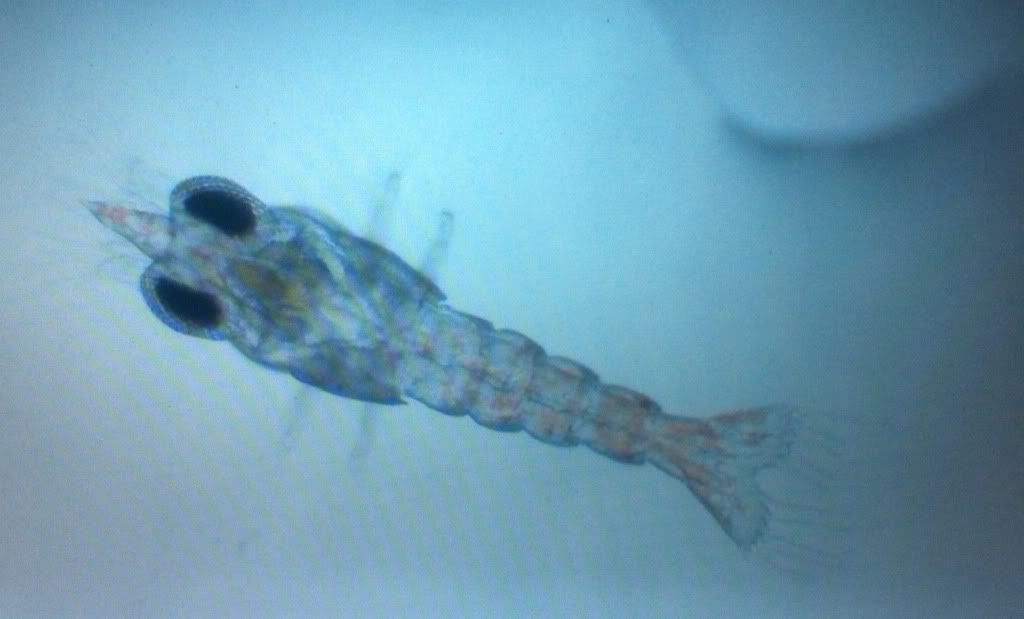 Bottom side: 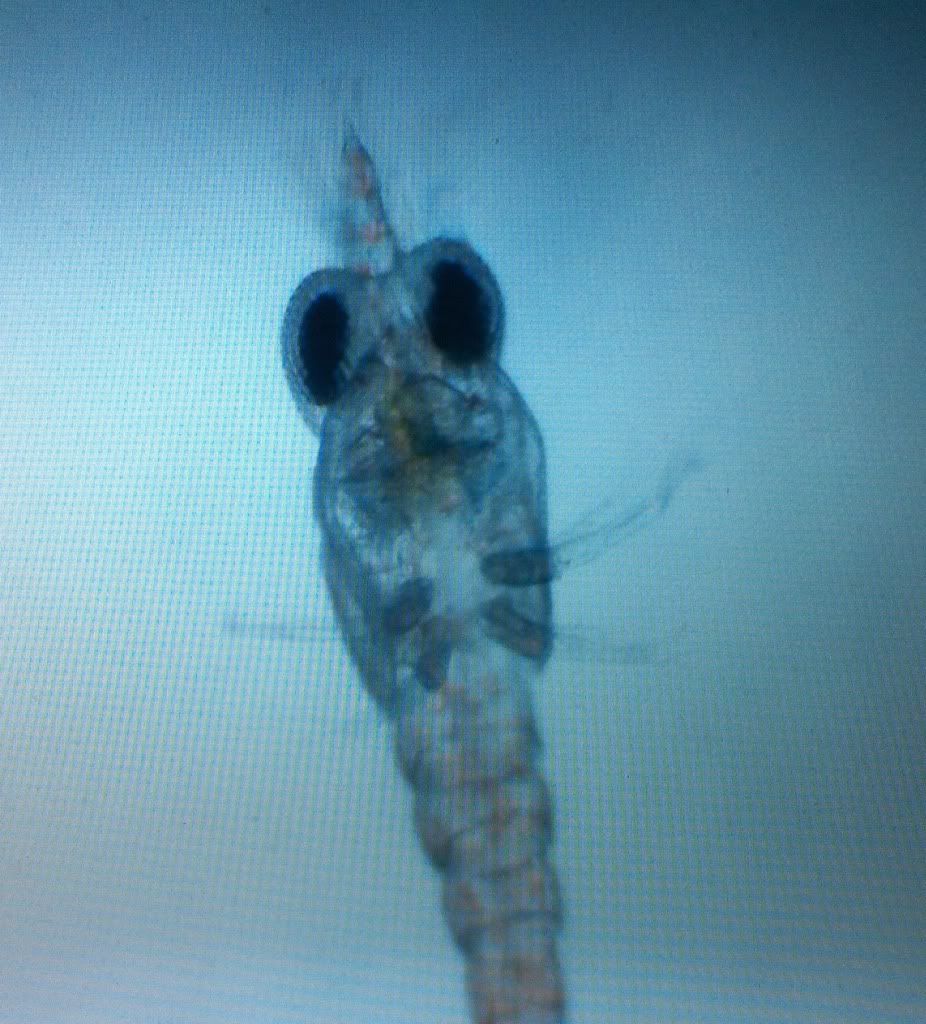 I have a thread around here somewhere from when I caught these in another tank of mine, and the images were taken with fancier microscope. I will try to scrounge that up and link it here later. The images above were taken yesterday on Day 1 of the first hatch I collected. I also collected more this morning and just added them to the same container.
|
|
|
 Re: Breeding Journal, Species: Clibanarius tricolor
Tuesday, September 3, 2013 9:00 AM
Re: Breeding Journal, Species: Clibanarius tricolor
Tuesday, September 3, 2013 9:00 AM
( permalink)
Here is the link to the other thread I had about hermit crab zoea. I can't say for certain that the ones in that thread are C. tricolor though since I have probably added more of a mix of hermits into that tank over time. They are probably C. tricolor since those are usually my go-to hermits, but... in any case, they are better microscope pics of a Clibanarius sp. zoea 1. http://www.mbisite.org/Forums/tm.aspx?m=74502
|
|
|
 Re: Breeding Journal, Species: Clibanarius tricolor
Wednesday, September 4, 2013 3:54 PM
Re: Breeding Journal, Species: Clibanarius tricolor
Wednesday, September 4, 2013 3:54 PM
( permalink)
Here are some pics taken today: No idea what the different zoea look like yet; I still have some research to do. 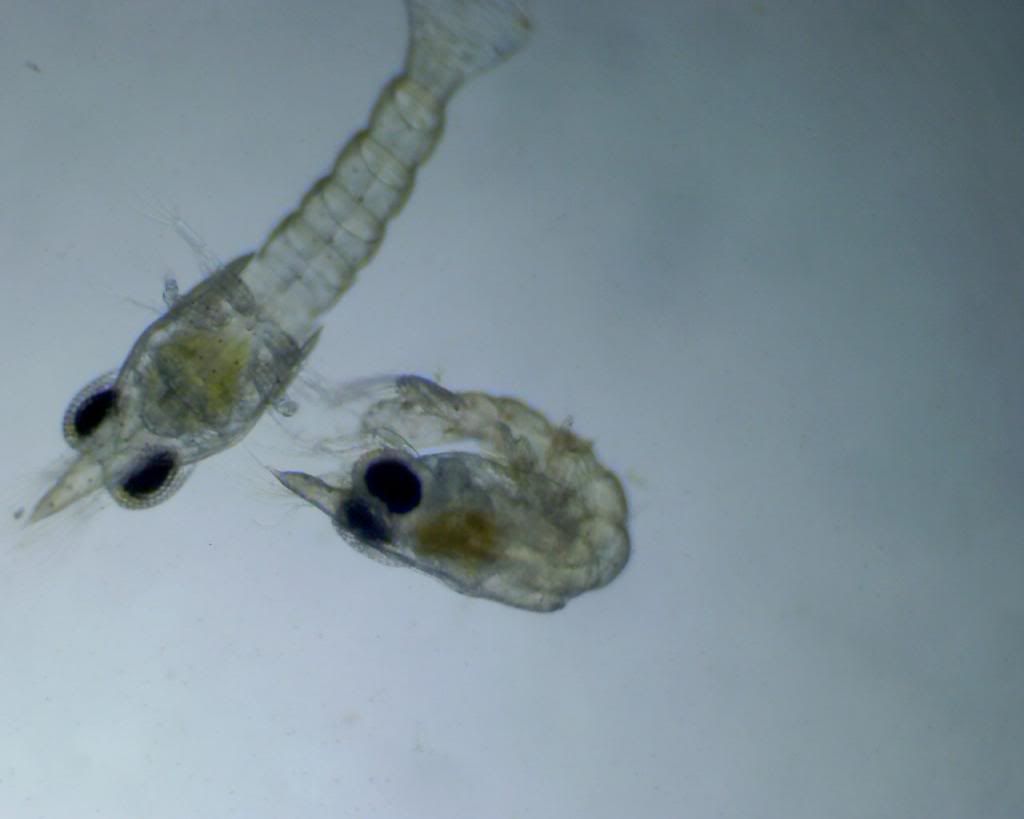 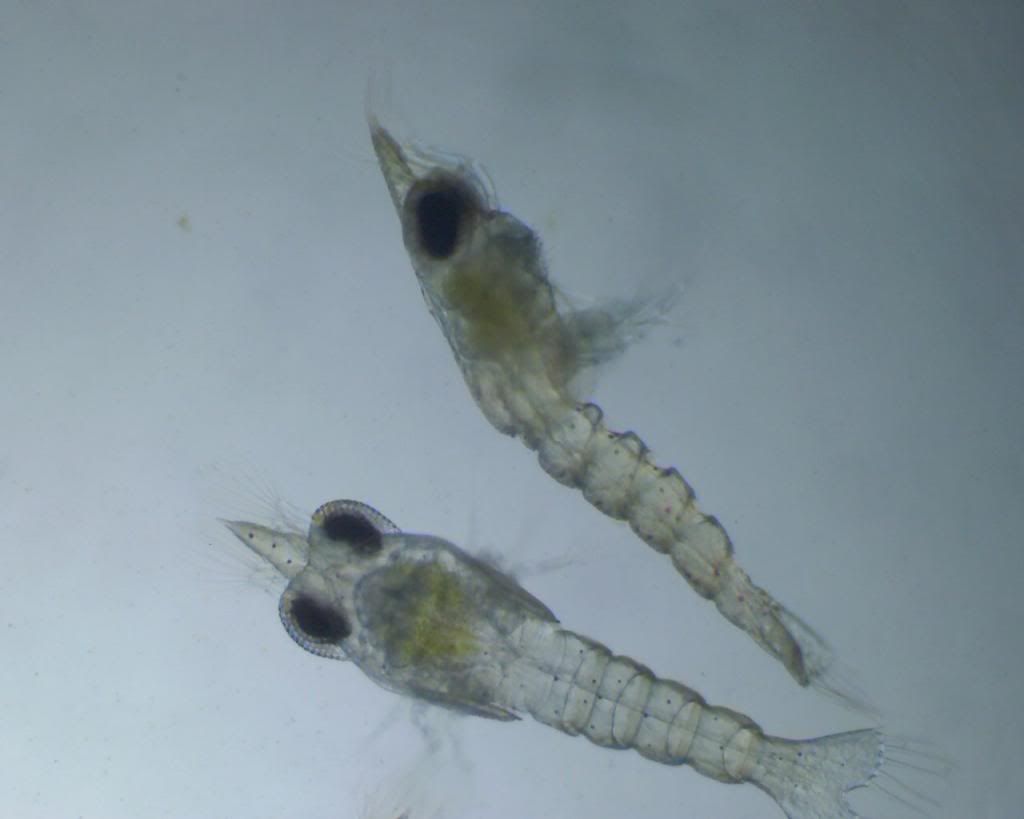 One is upside down and one is rightside up here: 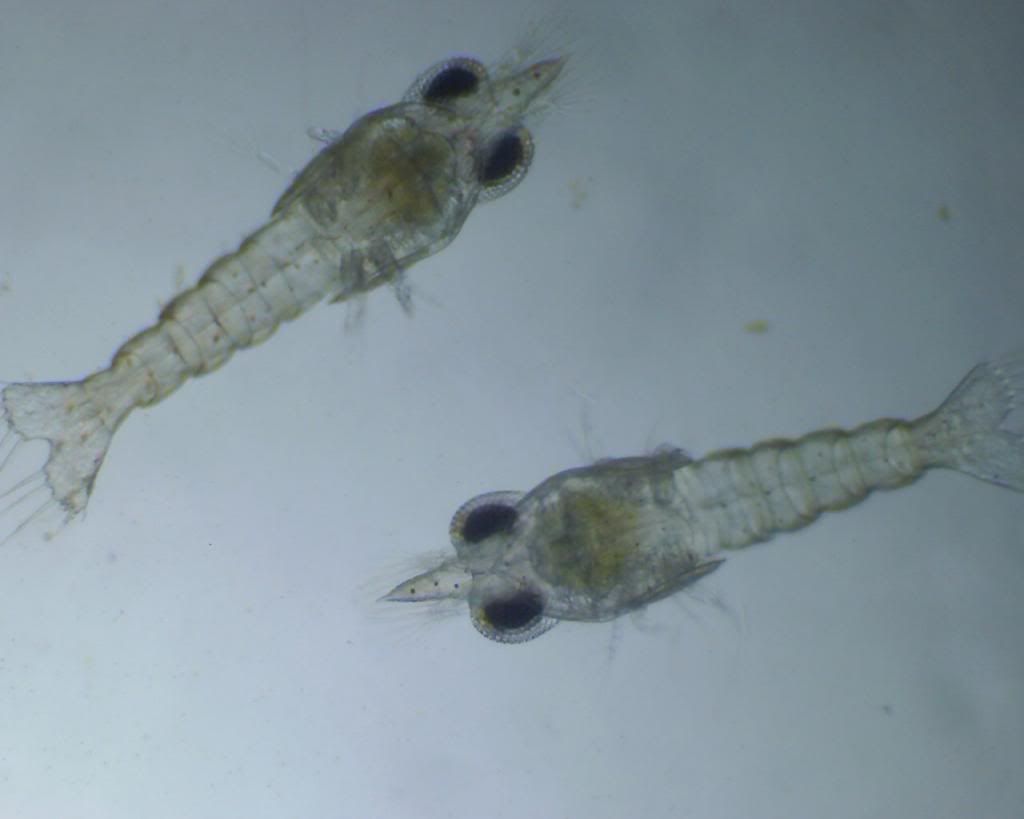 It's crazy that some of the brine shrimp put in with these guys the first day after hatch are already larger. At first I wasn't even sure there were any hermit larvae in the water pitcher anymore, but when I turned the air off to check you could tell there were still plenty. They get phyto about once a day to tint the water. I think I added some nhbbs this morning, but I honestly can't remember. There are still rotifers (L strain) and apocyclops in there as well.
|
|
|
 Re: Breeding Journal, Species: Clibanarius tricolor
Wednesday, September 4, 2013 4:47 PM
Re: Breeding Journal, Species: Clibanarius tricolor
Wednesday, September 4, 2013 4:47 PM
( permalink)
Based on "Larval development of the hermit crab Clibanarius albidigitus (Crustacea: Anomura: Diogenidae) reared under laboratory conditions" by Siddiqui, McLaughlin, and Crain and also "The larval development of Clibanarius vittatus (Bosc) (Crustacea: Decapoda: Diogenidae) reared in the laboratory" by Lang and Young, I would say that these are still in Zoea 1. Mainly I am determining this by looking at the telson (tail) and comparing it to the two different species (but same genus) and their different zoea stages. I started collecting pictures of the adult C. tricolor, but it will take awhile since they are often in difficult to photograph spots. I got a shot of one adult today, but the other adult I could see I wasn't able to get a good angle for a decent picture. 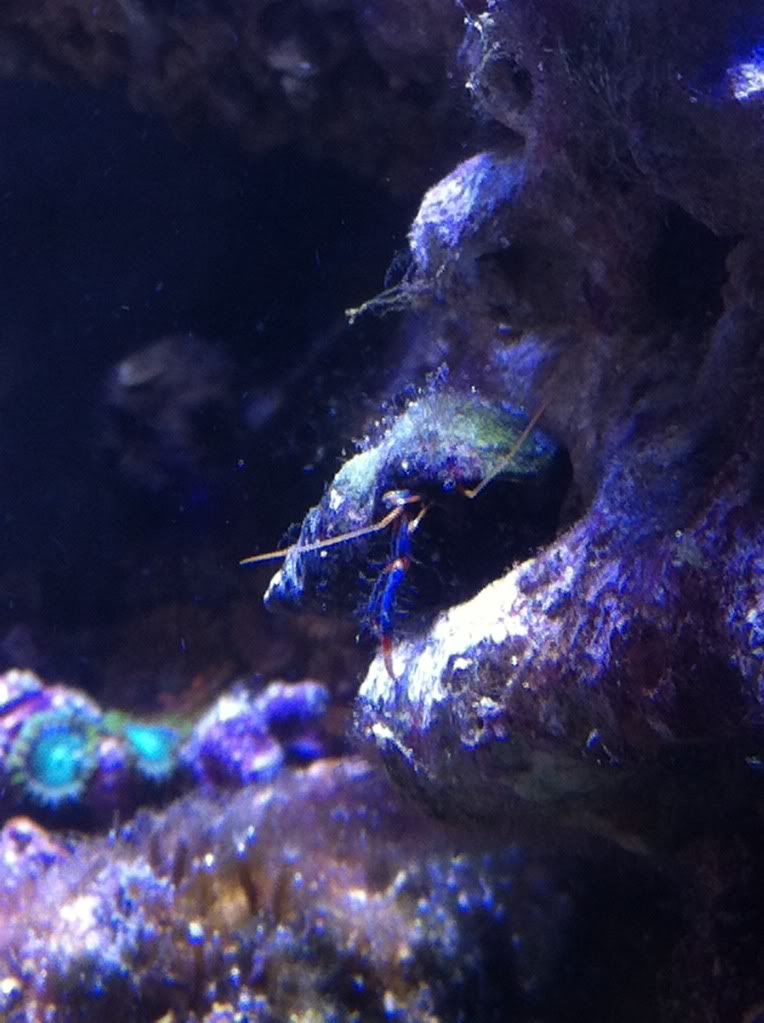
|
|
|
 Re: Breeding Journal, Species: Clibanarius tricolor
Tuesday, September 10, 2013 9:34 AM
Re: Breeding Journal, Species: Clibanarius tricolor
Tuesday, September 10, 2013 9:34 AM
( permalink)
Not many of these left that I can see in the water pitcher...but I did catch one last night and throw it under the scope. It looked like it was mid-molt because I could see the molt still attached to the carapace. Based on the telson, it was in Zoea II. I wasn't able to take any pictures because my computer is on the fritz and stopped recognizing my microscope camera 
|
|
|
 Re: Breeding Journal, Species: Clibanarius tricolor
Friday, September 13, 2013 11:04 PM
Re: Breeding Journal, Species: Clibanarius tricolor
Friday, September 13, 2013 11:04 PM
( permalink)
I thought these guys were done for, so today I went to empty the water pitcher they were in. Turns out there were still quite a few...perhaps even 50. So I bastered them out and put them in a new pitcher since the old one was overrun with rotifers and grown brine. I have them some nhbbs too and a sprinkling of golden pearls 100-200um. Day 13 for these guys and they are still zoea II base don a quick microscope check.
|
|
|
 Re: Breeding Journal, Species: Clibanarius tricolor
Saturday, September 14, 2013 3:01 PM
Re: Breeding Journal, Species: Clibanarius tricolor
Saturday, September 14, 2013 3:01 PM
( permalink)
Another hatch last night...hundreds and hundreds and hundreds it seems like. I threw them in another water pitcher with some nhbbs and a rigid airline.
|
|
|
 Re: Breeding Journal, Species: Clibanarius tricolor
Tuesday, September 17, 2013 11:05 PM
Re: Breeding Journal, Species: Clibanarius tricolor
Tuesday, September 17, 2013 11:05 PM
( permalink)
I checked the older batch under the scope today and they are at zoea III finally. I couldn't take any pics because I didn't have the right computer handy, but I hope to get some on Thursday. There are definitely less of them, but they are also significantly larger. They got a 50% water change today.
|
|
|
 Re: Breeding Journal, Species: Clibanarius tricolor
Thursday, September 19, 2013 3:27 PM
Re: Breeding Journal, Species: Clibanarius tricolor
Thursday, September 19, 2013 3:27 PM
( permalink)
I just got a hold of my other/better laptop and realized I had snapped a couple pictures of some zoea II last week. 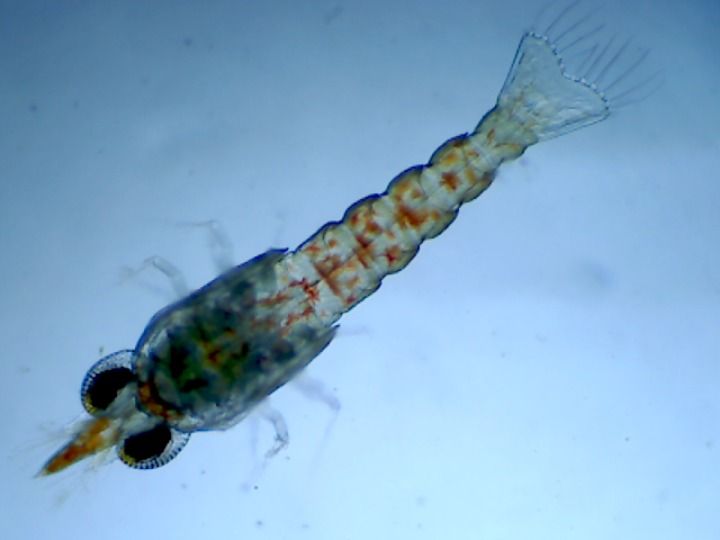 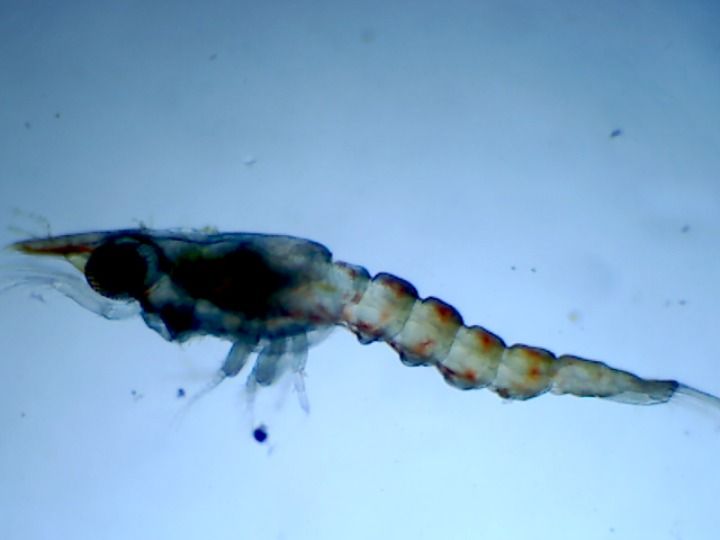 I haven't been able to find any papers about C. tricolor zoeal stages so far, so I am basing zoeal stage determination on published works for other similar species. I will probably mainly use the Lang and Young paper on C. vittatus since that species has five zoeal stages also (I am basing my assumption that C. tricolor has five zoeal and then the megalopa stage on a comment from "Spawner" in Matt P's C. tricolor thread on Reefcentral). Some other species such as C. albidigitus have four zoeal stages which I may refer to if needed. Tonight I will try to see if I can get some Zoea III pics!
|
|
|
 Re: Breeding Journal, Species: Clibanarius tricolor
Friday, September 20, 2013 9:57 AM
Re: Breeding Journal, Species: Clibanarius tricolor
Friday, September 20, 2013 9:57 AM
( permalink)
Some day 19 Zoea III pics I took last night: 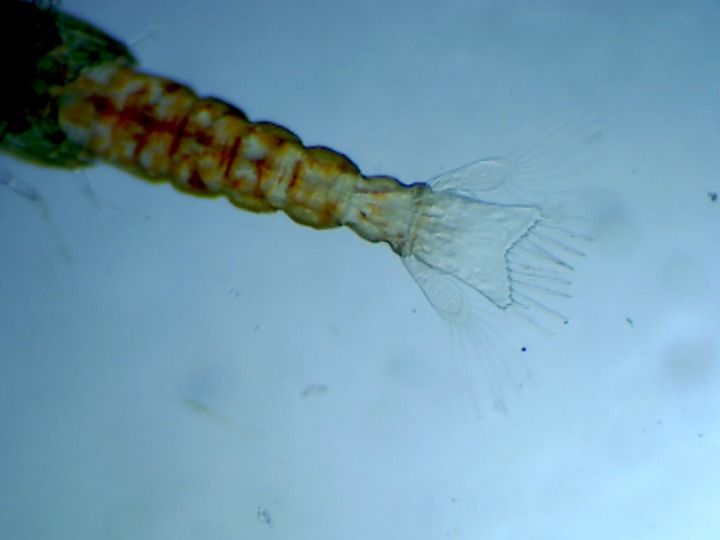 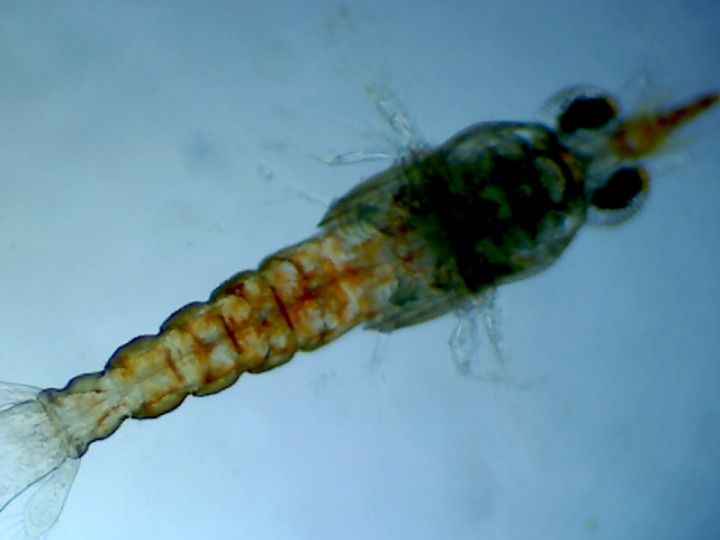 There aren't very many left of the 19 day ones. And when I peeked in the bowl with the younger ones I didn't spot any. I will do a 90% water change tonight and see if there are any in there yet.
|
|
|
 Re: Breeding Journal, Species: Clibanarius tricolor
Wednesday, September 25, 2013 10:08 AM
Re: Breeding Journal, Species: Clibanarius tricolor
Wednesday, September 25, 2013 10:08 AM
( permalink)
Day 22: 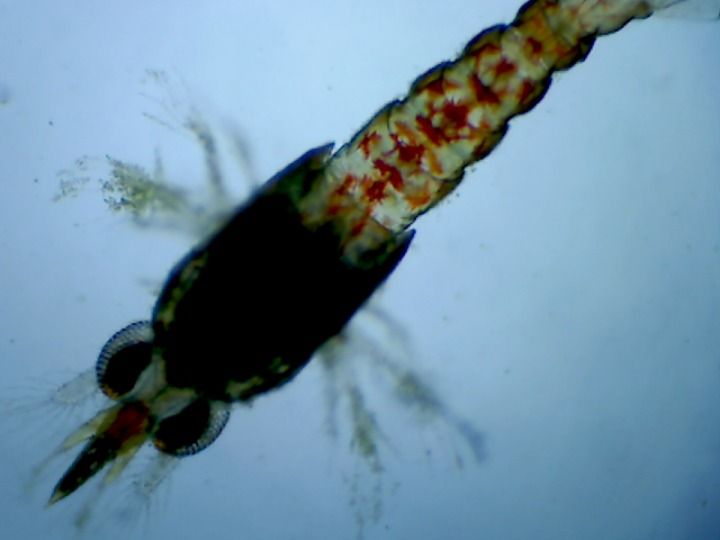 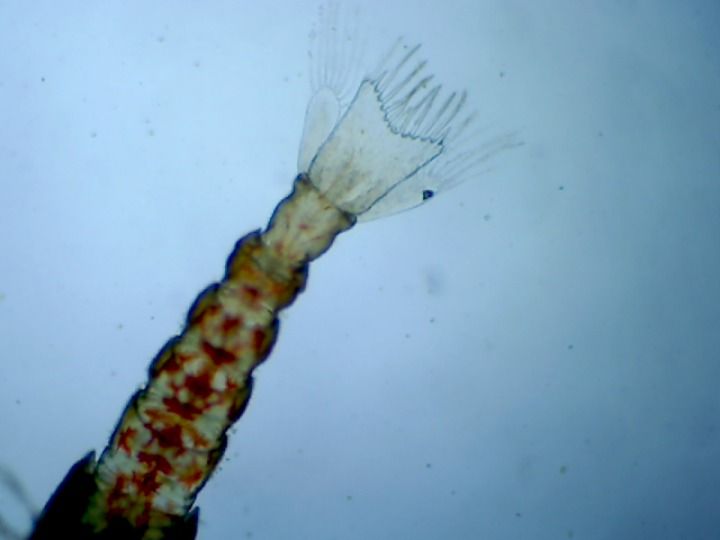 I think they look pretty close to day 19, and I wonder if they are both actually Zoea IV? Pretty sure the day 22 are Zoea IV but they look so similar to day 19 I am now uncertain if those were Zoea III or Zoea IV. It would be ideal to get them upside down so I could see the bottom side of the telson, but getting a top down shot is usually hard enough (I may have killed the one I took pics of last night trying to get top down shots of the telson...) Anywho, Day 25 today! Here are some pics from last night. I grabbed the biggest one which I think was the only Zoea V (FINALLY!) at the time. 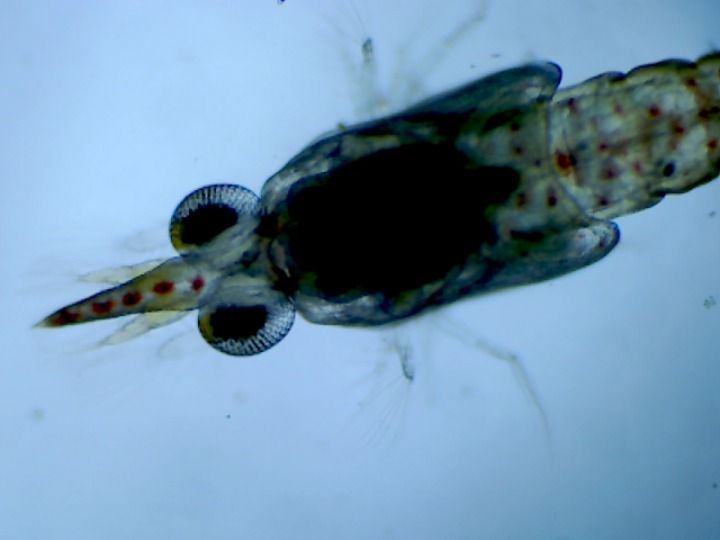 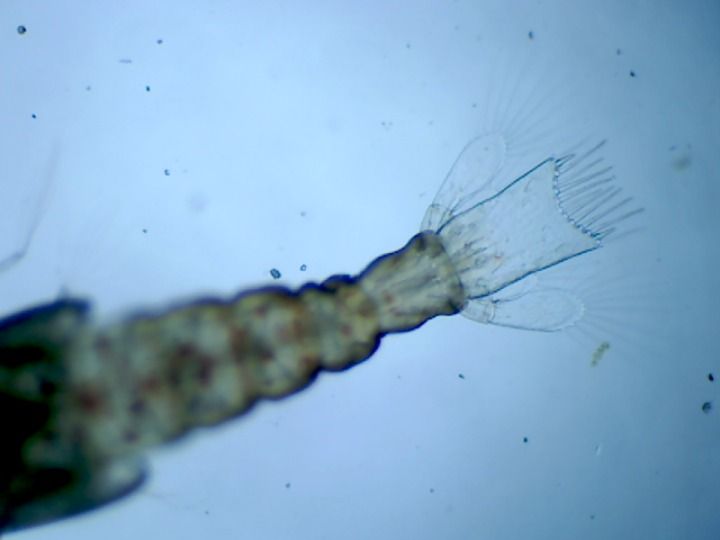 There really aren't many left of this oldest bunch...Hopefully some pull through to megalopa and then crab. I started thinking about tiny snail shells. The last couple times I did water changes on the systems with columbellid snails I saved any tiny juvenile shells I came across in the siphoned out gunk. I also picked through (with a tweezers and a flashlight. Tons of fun) a few cups of crushed coral substrate (straight out of the bag) and got as many of the snail shells out as I could find of various small sizes. I just need to clean them up a bit yet. I still have a bit of time though, and if they all die before then I won't have to worry about it anyway.
|
|
|
 Re: Breeding Journal, Species: Clibanarius tricolor
Tuesday, October 1, 2013 10:05 AM
Re: Breeding Journal, Species: Clibanarius tricolor
Tuesday, October 1, 2013 10:05 AM
( permalink)
Still alive...although I can't say if the ones I see are from the oldest bunch (~30 days old) or the younger bunch (~18 days old) and haven't had a chance to look at any of them up close. They are definitely bigger, that much I can say. Last night I added some tiny shells just in case.
Whopping big hatch last night. I collected and put them in a water pitcher at first, but they sort of just clumped on the bottom, so then I decided to put them in an inverted 3L bottle like I do for the Mithraculus forceps to keep them from settling on the bottom. I added nanno, nhbbs, and a small amount of rotifers. Rigid airline to keep the water moving and they are at room temperature.
|
|
|
 Re: Breeding Journal, Species: Clibanarius tricolor
Tuesday, October 1, 2013 12:24 PM
Re: Breeding Journal, Species: Clibanarius tricolor
Tuesday, October 1, 2013 12:24 PM
( permalink)
nice thread. i bred this species a few years ago. It took them about 25 days to reach metamorphosis with adults present. Without adults it took longer (about 35 to 40 days if i remember correctly).
|
|
|
 Re: Breeding Journal, Species: Clibanarius tricolor
Tuesday, October 1, 2013 12:30 PM
Re: Breeding Journal, Species: Clibanarius tricolor
Tuesday, October 1, 2013 12:30 PM
( permalink)
Good to know! I don't think I have spotted any megalopa yet...how long do they remain in that stage (if you remember)? Will they molt to megalopa without adults present? The adults won't eat them if I drop one in? It would make me pretty crabby (har har) to keep them alive this long only to put in an adult that eats them in the final hour!
Did you see better survival if they settled at 25 days with an adult vs. 35-40 days without an adult?
|
|
|
 Re: Breeding Journal, Species: Clibanarius tricolor
Tuesday, October 1, 2013 12:44 PM
Re: Breeding Journal, Species: Clibanarius tricolor
Tuesday, October 1, 2013 12:44 PM
( permalink)
yes they will molt to megalopa and eventually juvenile stage without adults. But IME the presence of adults really helps (settlement cue). Adults wont eat the larvae but you can keep them in a small net or something if you are worried about that. Juveniles/megalopae can use a wide range of shell sizes by the way
|
|
|
 Re: Breeding Journal, Species: Clibanarius tricolor
Friday, October 18, 2013 8:43 AM
Re: Breeding Journal, Species: Clibanarius tricolor
Friday, October 18, 2013 8:43 AM
( permalink)
Day 16 for the younger batch and day 35 for the older batch (as of today). They are both still in water pitchers at room temp (each is in its own pitcher) and get nhbbs when I remember (usually once a day) and live phyto when I have some extra. Last night I peeked in the containers and saw a couple megalopa in the older batch! 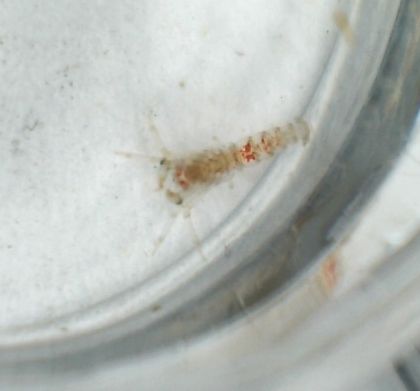 Debating if I want to add an adult to move settlement along...maybe I will this weekend. The containers need water changes anyway since they are pretty overrun with brine shrimp.
<message edited by shannpeach on Friday, October 18, 2013 9:54 AM>
|
|
|
 Re: Breeding Journal, Species: Clibanarius tricolor
Sunday, October 20, 2013 3:00 AM
Re: Breeding Journal, Species: Clibanarius tricolor
Sunday, October 20, 2013 3:00 AM
( permalink)
FANTASTIC!!! Wow..this is awesome 
|
|
|
 Re: Breeding Journal, Species: Clibanarius tricolor
Monday, October 21, 2013 8:55 AM
Re: Breeding Journal, Species: Clibanarius tricolor
Monday, October 21, 2013 8:55 AM
( permalink)
Thanks  I want to give them a more dedicated effort, but I don't have things set up the way I want/need to do that yet. Perhaps soon, though. I did large water changes on both containers this weekend and started them off again with some live phyto (tet and chaet) and also nhbbs. I think I am going to need to add some slightly larger shells because the megalopae are a bit bigger than I expected them to be.
|
|
|
 Re: Breeding Journal, Species: Clibanarius tricolor
Monday, October 28, 2013 12:40 PM
Re: Breeding Journal, Species: Clibanarius tricolor
Monday, October 28, 2013 12:40 PM
( permalink)
These are at day 44 or so (IIRC off the top of my head) and STILL haven't settled. I only have six, which I think is pretty good considering the amount of neglect they have taken. I think I may need to add an adult crab today to move this along...
|
|
|
|